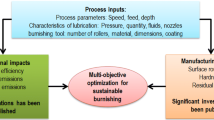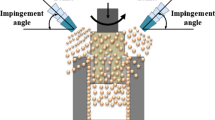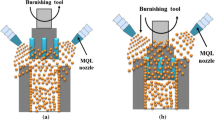Abstract
Internal burnishing operation is a prominent solution to improve the hole quality. In this study, minimum quantity lubrication (MQL) system parameters, including the diameter of the nozzle (N), impingement angle (I), the pressure of the compressed air (P), the flow rate of the lubricant (L), and the distance between the nozzle and workpiece (D) are optimized for decreasing the total energy consumption (TE), average surface roughness (AR), and air quality indicator (AI) of the internal roller burnishing process. The predictive models of performance measures were developed using the adaptive neuro-based-fuzzy inference system (ANFIS) approach, while a novel model is developed to compute the total burnishing cost (BC). The neighborhood cultivation genetic algorithm (NCGA) and the VIKOR method were used to generate a set of prominent solutions and determine the best selection. The outcomes presented that the optimizing values of the N, I, P, L, and D are 1.0 mm, 35 deg., 0.3 MPa, 70 ml/h, and 10 mm, respectively. The TE, AI, AR, and BC are decreased by 3.1, 9.3, 20.6, and 7.9%, respectively, at the chosen point. The proposed performance measures could be utilized to precisely forecast the responses in the practical burnishing. The developed optimizing method combining the ANFIS, NCGA, and VIKOR could be effectively utilized to deal with complicated optimization issues for machining operations. The observed findings provided efficient information, which could help machine operators to select the optimal MQL system parameters and enhance the burnishing performances.
















Similar content being viewed by others
Data availability
of laborers serving burnishing operations.
Abbreviations
- AI:
-
Air quality indicator (µg/m3)
- AR:
-
Average surface roughness (µm)
- BC:
-
Burnishing cost (USD)
- BD:
-
Burnishing depth (mm)
- BS:
-
Burnishing speed (m/min)
- D:
-
Distance between the nozzle and workpiece (mm)
- FR:
-
Feed rate (mm/rev)
- I:
-
Impingement angle (deg)
- L:
-
Flow rate of the lubricant (ml/h)
- MQL:
-
Minimum quantity lubrication
- N:
-
Diameter of the nozzle (mm)
- P:
-
Pressure of the compressed air (MPa)
References
Alptekin B, Acitas S, Senoglu B et al (2022) Statistical determination of significant particle swarm optimization parameters: the case of Weibull distribution. Soft Comput 26:12623–12634
Amdouni H, Bouzaiene H, Montagne A et al (2017) Experimental study of a six new ball-burnishing strategies effects on the Al-alloy flat surfaces integrity enhancement. Int J Adv Manuf Technol 90:2271–2282
Amini S, Bagheri A, Teimouri R (2018) Ultrasonic-assisted ball burnishing of aluminum 6061 and AISI 1045 steel. Mater Manuf Process 33:1250–1259
Attabi S, Himour A, Laouar L et al (2021) Effect of ball burnishing on surface roughness and wear of AISI 316L SS. J Bio Tribo Corros 7:7
Banh QN, Shiou FJ (216) Determination of optimal small ball-burnishing parameters for both surface roughness and superficial hardness improvement. Arab J Sci Eng. 41: 639-652.
Bourebia M, Hamadache H, Lakhdar L et al (2021) Effect of ball burnishing process on mechanical properties and impact behavior of S355JR steel. Int J Adv Manuf Technol 116:1373–1384
Buldum B, Cagan S (2018) Study of Ball Burnishing Process on the Surface Roughness and Microhardness of AZ91D Alloy. Exp Tech 42:233–241
Cagan SC, Buldum BB, Ozkul I (2019) Experimental investigation on the ball burnishing of carbon fiber reinforced polymer. Mater Manuf Process 34:1062–1067
Chang W, Zheng W (2022) Compressive strength evaluation of concrete confined with spiral stirrups by using adaptive neuro-fuzzy inference system (ANFIS). Soft Comput 26:11873–11889
Diyaley S, Chakraborty S (2021) Teaching-learning-based optimization of ring and rotor spinning processes. Soft Comput 25:10287–10307
García-Granada AA, Gomez-Gras G, Jerez-Mesa R, Antonio Travieso-Rodriguez J, Reyes G (2017) Ball-burnishing effect on deep residual stress on AISI 1038 and AA2017-T4. Mater Manuf Process 32:1279–1289
Gürgen S, Çakır FH, Sofuoğlu MA et al (2019) Multi-criteria decision-making analysis of different non-traditional machining operations of Ti6Al4V. Soft Comput 23:5259–5272
Jalota S, Suthar M (2023) Prediction of Marshall stability of asphalt concrete reinforced with polypropylene fibre using different soft computing techniques. Soft Comput. https://doi.org/10.1007/s00500-023-08339-x
Jerez-Mesa R, Travieso-Rodriguez JA, Gomez-Gras G, Lluma-Fuentes J (2018) Development, characterization and test of an ultrasonic vibration-assisted ball burnishing tool. J Mater Process Technol 257:203–212
Jerez-Mesa R, Fargas G, Roa JJ, Llumà J, Travieso-Rodriguez JA (2021) Superficial effects of ball burnishing on TRIP steel AISI 301LN sheets. Metals 11:82
Kalam R, Thomas C, Rahiman MA (2023) Brain tumor detection in MRI images using Adaptive-ANFIS classifier with segmentation of tumor and edema. Soft Comput 27:2279–2297
Khan A, Ahmad U, Shahzadi S (2023) A new decision analysis based on 2-tuple linguistic q-rung picture fuzzy ITARA–VIKOR method. Soft Comput. https://doi.org/10.1007/s00500-023-08263-0
Maji K, Kumar G (2020) Inverse analysis and multi-objective optimization of single-point incremental forming of AA5083 aluminum alloy sheet. Soft Comput 24:4505–4521
Mohiuddin AM, Bansal JC (2023) An improved linear prediction evolution algorithm based on nonlinear least square fitting model for optimization. Soft Comput. https://doi.org/10.1007/s00500-023-08500-6
Nguyen TT, Le XB (2018) Optimization of interior roller burnishing process for improving surface quality. Mater Manuf Process 33:1233–1241
Nguyen TT, Le XB (2019) Optimization of roller burnishing process using Kriging model to improve surface properties. Proc Inst Mech Eng B 233:2264–2282
Nguyen TT, Le MT (2021a) Optimization of internal burnishing operation for energy efficiency, machined quality, and noise emission. Int J Adv Manuf Technol 114:2115–2139
Nguyen T, Le T (2021b) Optimization of the internal roller burnishing process for energy reduction and surface properties. Stroj Vestn-J Mech E 67:167–179
Nguyen TT, Van AL (2023) Machining and optimization of the external diamond burnishing operation. Mater Manuf Process 38:1276–1290
Nguyen TT, Nguyen TA, Trinh QH, Le XB (2022) Multi-performance optimization of multi-roller burnishing process in sustainable lubrication condition. Mater Manuf Process 37:407–427
Nguyen TT, Nguyen TA, Dang XB, Van AL (2023) Multi-performance optimization of the diamond burnishing process in terms of energy saving and tribological factors. P I Mech Eng E-J pro. https://doi.org/10.1177/09544089231163407
Patel KA, Brahmbhatt PK (2018) Response surface methodology based desirability approach for optimization of roller burnishing process parameter. J Inst Eng India Ser C 99:729–736
Pohrelyuk IM, Fedirko VM, Lavrys SM (2017) Effect of preliminary ball burnishing on wear resistance of the nitrided VT22 alloy. J Frict Wear 38:221–224
Revankar GD, Shetty R, Rao SS, Gaitonde VN (2017) Wear resistance enhancement of titanium alloy (Ti–6Al–4V) by ball burnishing process. J Mater Res Technol 6:13–32
Sachin B, Narendranath S, Chakradhar D (2019) Selection of optimal process parameters in sustainable diamond burnishing of 17–4 PH stainless steel. J Braz Soc Mech Sci Eng 39:3089–3310
Saha S, Maity SR, Dey S et al (2021) Modeling and combined application of MOEA/D and TOPSIS to optimize WEDM performances of A286 superalloy. Soft Comput 25:14697–21471
Samantaray S, Biswakalyani C, Singh DK et al (2022) Prediction of groundwater fluctuation based on hybrid ANFIS-GWO approach in arid Watershed India. Soft Comput 26:5251–5273
Shajin FH, Aruna Devi B, Prakash NB et al (2023) Sailfish optimizer with Levy flight, chaotic and opposition-based multi-level thresholding for medical image segmentation. Soft Comput. https://doi.org/10.1007/s00500-023-07891-w
Skoczylas A, Zaleski K, Matuszak J, Ciecieląg K, Zaleski R, Gorgol M (2022) Influence of slide burnishing parameters on the surface layer properties of stainless steel and mean positron lifetime. Materials 15:8131
Stalin John MR, Banerjee N, Shrivastava K et al (2017a) Optimization of roller burnishing process on EN-9 grade alloy steel using response surface methodology. J Braz Soc Mech Sci Eng 39:3089–3310
Stalin John MR, Balaji B, Vinayagam BK (2017b) Optimisation of internal roller burnishing process in CNC machining center using response surface methodology. J Braz Soc Mech Sci Eng 39:4045–4057
Teimouri R, Amini S (2019) A comprehensive optimization of ultrasonic burnishing process regarding energy efficiency and workpiece quality. Surf Coat Technol 375:229–242
Teimouri R, Amini S, Bami AB (2018) Evaluation of optimized surface properties and residual stress in ultrasonic assisted ball burnishing of AA6061-T6. Measurement 116:129–139
Vukelic D, Tadic B, Dzunic D et al (2017) Analysis of ball-burnishing impact on barrier properties of wood workpieces. Int J Adv Manuf Technol 92:129–138
Yuan X, Sun Y, Li C et al (2017) Experimental investigation into the effect of low plasticity burnishing parameters on the surface integrity of TA2. Int J Adv Manuf Technol 88:1089–1099
Yue C (2022) A VIKOR-based group decision-making approach to software reliability evaluation. Soft Comput 26:9445–9464
Funding
The authors have not disclosed any funding
Enquiries about data availability should be directed to the authors
Author information
Authors and Affiliations
Corresponding author
Ethics declarations
Conflict of interest
The author declares that he has no conflict of interest.
Ethical approval
This article does not contain any studies with human participants or animals performed by any of the authors.
Additional information
Publisher's Note
Springer Nature remains neutral with regard to jurisdictional claims in published maps and institutional affiliations.
Rights and permissions
Springer Nature or its licensor (e.g. a society or other partner) holds exclusive rights to this article under a publishing agreement with the author(s) or other rightsholder(s); author self-archiving of the accepted manuscript version of this article is solely governed by the terms of such publishing agreement and applicable law.
About this article
Cite this article
Van, AL., Nguyen, TT., Dang, XB. et al. Multi-objective optimization of MQL system parameters for the roller burnishing operation for energy saving, product quality and air pollution. Soft Comput 28, 1229–1254 (2024). https://doi.org/10.1007/s00500-023-09165-x
Accepted:
Published:
Issue Date:
DOI: https://doi.org/10.1007/s00500-023-09165-x




